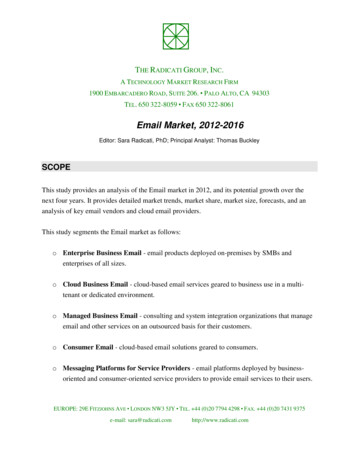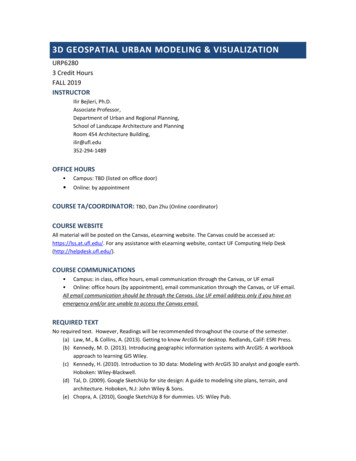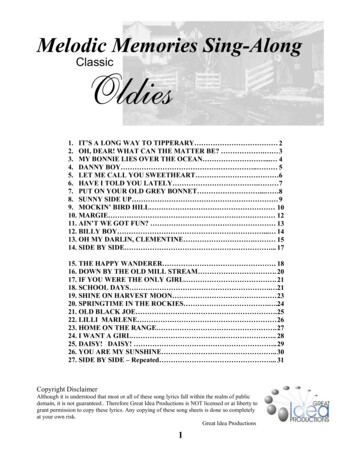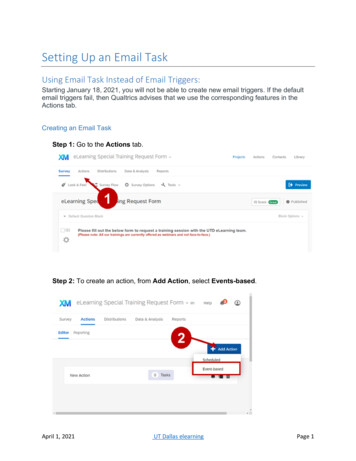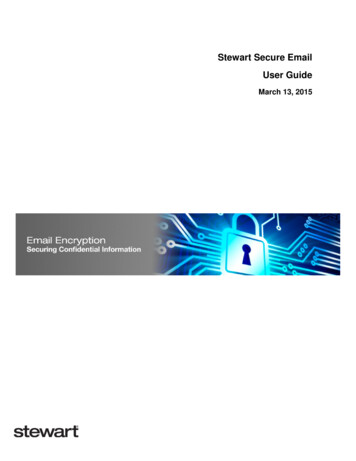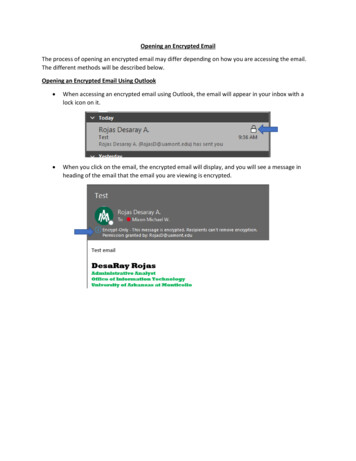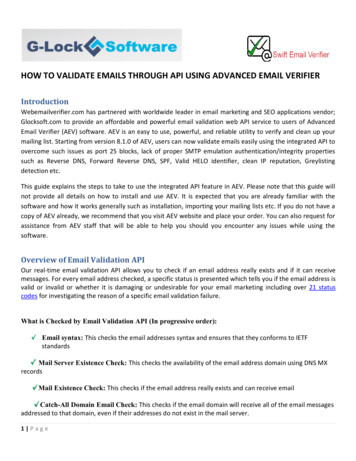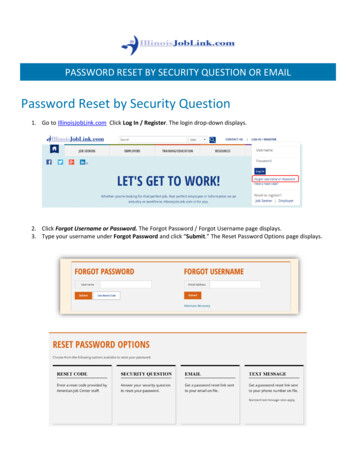
Transcription
White PaperHow Long Should Email Be Saved?Sponsored by Symantec, Inc.Copyright 2007 Contoural, Inc.
How Long Should Email Be Saved?Table of ContentsIntroduction . 3Considering Email retention . 3Can IT Set Email Retention Policy? . 4Best Practices . 4What Does An Email Retention Policy Look Like? . 5Determining Email Retention Periods: Keep it Simple . 5General Business Correspondence . 6Functional Departments, Titles or Names . 6Managing Exceptions . 6Regulatory Compliance Requirements . 6What Are The Key Elements Of An Effective Records Retention Program? . 8Create a Core Team . 8Assessment . 8Record Retention Policy and Schedule . 8Solution Implementation Planning . 9Education and Training . 9Audit . 9Implementing Your New Policies . 9Getting Help . 9Using Enterprise Vault . 10Conclusion . 10About Contoural, Inc. . 12About Symantec Enterprise Vault . 13Copyright 2007 Contoural, IncPage 2 of 13
How Long Should Email Be Saved?Note: Legal information is not legal advice. Contoural provides information pertaining tobusiness, compliance, and litigation trends and issues for educational and planning purposes.Contoural and its consultants do not provide legal advice. Readers should consult with competentlegal counsel.IntroductionAs email has become more critical in the business world, many companies are weighing thequestion of how long it should be retained, what should be done with it, and when it should bedeleted. The answer depends on many issues, particularly when one considers the varyingregulations and business situations that might demand emails to be archived for long periods oftime. This white paper examines the reality of records retention and email archiving, focusing onthe process of developing an effective retention policy and automating solutions to enforce rulesand satisfy retention obligations. Contoural will also recommend best practices for emailretention and real world examples.Considering Email retentionAs many high-profile cases have shown, failure to comply with an e-discovery request for e-mailas part of the litigation process can have a tremendous impact on businesses. Numerous internalpolicies and external regulations call forlong-term retention and preservation ofemail, and many business circumstancesManual vs. Automaticdemand recovery of historic messages aswell. To ensure organizations will be ableWhen considering e-mail message retention,to meet these twin demands of litigationIT organizations have a key decision to make:and legislation, all organizations, from theShould users manually classify messages?smallest private companies to the largestgovernment agencies, must create a policyorregarding long-term storage and handlingShould an attempt to be made to automate thisof email messages.task?Recent studies show that nearly half of allManual classification is simpler to implement,companies have some policy for emailbut difficult to get right. As users decideretention, but less than one in eight haswhich messages to keep and how to classifyimplemented an automated solution tothem, inconsistencies are bound to spring up,ensure requirements are met. Having anand productivity is lost. Automation canun-enforced policy is the worst possibleensure consistent classification, but it isscenario. Organizations can be held legallydifficult to create a system that recognizes theliable if their policies are not strictlynuances of business communication. An idealfollowed, and only an automated systemsystem would combine the best of bothcan help ensure compliance.worlds, automating simple tasks andEmail is a special, and critical, example ofrequesting user input for more complexan application that, by default, lacksdecisions.retention enforcement. Modern emailsystems are designed to be the hub of highvolume, daily communication. Applyingrecord retention periods usually requires the addition of a third-party application. Relying onusers to manually apply corporate retention policies is not only naïve but technically impractical.Copyright 2007 Contoural, IncPage 3 of 13
How Long Should Email Be Saved?The daily volume of email entering and exiting each user’s mailbox, multiplied across the entireenterprise, necessitates an automated solution to enforce policy.Email has other unique aspects as well. Although email has more structured metadata than mostcorporate applications in the form of headers, some content lacks standards. Subject lines, or evenaddresses, cannot be relied upon to be specific, consistent, or unique. The proliferation of emailattachments creates another unique challenge, with encoded files frequently retransmitted andoften containing key contextual information. Ironically, the flexibility of email as acommunication mechanism undermines its inherent structure.Over the last few years, email has also become the primary target for discovery requests duringbusiness related litigation. Here again, the flexibility and democratic nature of e-mailcommunication works against the needs of corporate counsel. In the event of a legal hold request,all relevant files and emails must be immediately preserved, and most e-mail software isincapable of this type of retention. Litigation hold is a joint responsibility of both the IT staff andthe legal department, so it clear process must be put in place to communicate hold requirements.This communication must include information about the date and scope of the request, whichlocations and employees are covered, and the specific records or content that must be retained.Since legal actions can sometimes drag on, IT must also consider how it would handle continuedretention for a long period of time.Can IT Set Email Retention Policy?Although IT organizations have proven adept at creating and managing complex technicalsystems, the creation of business policies has often proven troublesome. Indeed, it is unrealisticto expect the technical organization to create business policy in isolation. Instead, a consensusmust be developed with a wide range of opinions throughout the organization.Although the final, complete policy for email retention cannot be produced by the IT staff alone,they can produce a workable draft policy grounded in the technical capabilities of e-mailarchiving software. Once this draft is circulated, it can be tuned to meet the expectations of thebusiness, and integrated into a wider record retention policy. In general, the input from legal,finance, human resources, and business units will be integrated with the consensus from ITmanagement, storage, and messaging representatives.Best PracticesAlthough policies vary based on business circumstances, some universal best practices can bedistilled from the experience of many organizations. The following practices are applicable tomost email retention systems:1. An email archiving policy should be part of an overall records management program,which has its own record retention policies and procedures.2. The scope of the policy should consider all employees who create, send or receive emailmessages and attachments.3. The email archiving policy should refer to IT’s Acceptable Use Policy and expand uponthe areas specifically related to email use.4. The policy should state whether users can create PST files to store email messages.5. Data privacy issues should be addressed. Employees should have no expectation ofprivacy when using company resources for email and could be subject to discoveryproceedings and legal actions.Copyright 2007 Contoural, IncPage 4 of 13
How Long Should Email Be Saved?6. The policy must clearly state how and where email records will be managed, protectedand retained.7. The policy should explain how IT handles exceptions to the retention settings (e.g., somecountries will require significantly longer retention periods for certain types of records).8. Managers and users must be provided with training and support.9. Compliance with the policy must be mandatory for all employees and include compliancein an internal audit review.10. Review the policy yearly to ensure compliance with any changes or new regulations.Taking these best practices taken into account and adding any organization-specific element, adraft email archiving policy can be created by IT as a way to kick-off an overall record retentionpolicy modernization effort.What Does An Email Retention Policy Look Like?The key to creating an effective automated e-mail retention system is to keep the retention policyas simple as possible. Not only does simple approach assist in implementation, it also allowsongoing management and monitoring using common sense rather than complex rules. Therefore,an effective email retention policy should beshort, specific, and cover 95% of all messageElements an Email Policytraffic. Any exceptions will be handledAn email-retention policy should cover allmanually as needed.employees, contractors, and others related to theOne key question to answer when creating ancompany who create, send, or receive e-mailemail retention policy is the length of timemessages. It should be clear that, in addition to thethat most messages will be retained. Inmessage body, attachments and headers, includingaddition to the cost of long term storage,addresses and hidden information, are also part ofthere are risks in retaining data as well as inthe policy.deleting it. Most companies come to theThe email policy must specify the followingconclusion that many messages should bestandards:retained for a few years for businessproductivity purposes. Once retention Acceptable use of the email systemstretches beyond the memory of users, it Unacceptable uses of emailmust be indexed and searchable, whichnormally means keeping messages online Offline copies of email messagesrather than on tape. Privacy issues and local regulationsDetermining Email RetentionPeriods: Keep it Simple Email management and retention policies Responsibilities of the staffOver time, the cost of disk storage continues Auditing and processes for dealing withto decline while the length of time messagesviolationsare retained climbs. Could email storagecosts become irrelevant? For instance, thetotal size of a large enterprise messaging system from ten years ago was likely to be measured inmegabytes while five years of email storage may be measured in the tens of gigabytes. Althoughthese appeared to be large numbers at the time, they are small compared to today’s enterprisestorage capacity. Assuming the cost per gigabyte of storage continues to decline, one coulddeduce that all messages should be retained forever,.Copyright 2007 Contoural, IncPage 5 of 13
How Long Should Email Be Saved?However, there are risks with long-term retention. As the volume of messages increases, the costof complying with e-discovery request increases as well. A higher volume of messages combinedwith more powerful search capabilities, can lead to escalating demands on the IT and thearchiving solution. A larger message store could also expose the company to legalentanglements, (i.e., the ―smoking gun‖ email message), that otherwise could have beenavoided if messages were routinely deleted. In the end, the risk and cost of long-term retentionmust be balanced against the desire for a complete archive of email messages.General Business CorrespondenceAs stated earlier, the goal of an email archiving solution is to automate the retention, expiry andclassification and retention of 95% of all messages. When creating an email retention policyusing an automated solution, group messages with similar retention needs logically such as byfunction, department or title. Most email messages can be classified as general businesscorrespondence with a suggested default retention period of three- to five- years. This single rulewill probably cover the majority of all email messages.Functional Departments, Titles or NamesNext, find universal and logical criteria to identify and classify the remaining email messages.Experience has shown that two more key criteria will cover these communications: criticalorganizational departments, and key individuals. Critical departments typically include finance,which may need a retention period of ten years or longer for tax purposes, as well as humanresources and legal staff. Certain key management figures or company officials may needindefinite retention of email messages. Include corporate executives, who may have a fiduciaryresponsibility to the company, as well as directors and members of corporate governance boards.Managing ExceptionsA small percentage of email messages will have to be categorized manually. Employees willneed to be trained on how to recognize which messages will be exceptions to the general policy,as well as what their retention period should be. Of particular importance are apparentlymundane messages whose attachments or context make them critically important. These willhave to be managed manually by those familiar with their content. The retention period forexceptional messages will require some research into the specifics of an organization’s businessfunctions, and must be done with an eye toward a larger record retention management program.Regulatory Compliance RequirementsA wide variety of regulations and standards apply to record retention, and email can be avehicle for these records. Different regulations will apply to different departments withinevery business – human resources may concern themselves with HIPAA, facilities may beconcerned with OSHA, and finance may focus on Sarbanes-Oxley. Therefore, it makes senseto target the email archiving solution by department or area of responsibility in order to alignit with record retention regulations.The table below shows many of the regulations that might affect record retention and securityrequirements. Some affect certain market sectors or corporate constituencies, while othersare region-specific or focus on public companies or manufacturers.Copyright 2007 Contoural, IncPage 6 of 13
How Long Should Email Be Saved?SectorSpecificRegulationsFinancial ServicesSECRule17a-4PATRIOTActHealth ServicesBasel IIHIPAALife Science21 CFR11CMIAUK GMPSarbanes-Oxley Act (Enforced by -Bliley Act(GLBA)SB 1386Data Protection Act (UK) and similar lawsimplementing EU DirectivesEU GMP Directive 91/356/EEC-9UK Public RecordsNote that most regulations do not specify the mechanism or schedule of record retention.Instead, they detail the desired outcome, whether that is protecting confidential informationor producing critical records on demand. However, some regulations do specify retentionperiods for certain record types, as illustrated below.Regulation21 CFR Part11HIPAASarbanesOxleySEC ancialservicesAreaYears ofRetentionNoteClinical trials35Thirty five years from creationFood manufacturing,processing, and packaging2Two years after commercial releaseDrug manufacturing,processing, and packaging3Three years after commercialreleaseManufacturing of biologicalproducts 5Five years after the end ofmanufacturingPediatric medical records 21Until age 21Adult medical records 2Up to two years after a patient'sdeathDocumentation related tosecurity6Six years from date of creationAudit-related records 7Seven years after the conclusion ofthe reviewAccount records 6Six years after closing the accountFinancial statements,transaction records,communications3Two years easily accessible, threeyears totalMember registration andcorporate documentation For the life of the enterpriseNote retentions vary relative to different areas of focus: Some concern the lifespan ofindividual people, others refer to the beginning or end of a product’s development, and othersare specific to a document or other record. When they take effect also varies – some startcounting at creation while others are ―term plus‖, adding years after an event. AnotherCopyright 2007 Contoural, IncPage 7 of 13
How Long Should Email Be Saved?consideration is whether the regulation calls for a positive end or not – some demand anaction at a certain time, while others are minimums.This can get quite confusing. HIPAA, for example, calls for retaining adult medical recordsonly for two years after a patient’s death but retaining pediatric records until the patientreaches the age of 21. This means that a retention scheduler would have to have access tobirth dates and death records, which would likely be injected come from an outside source.Automating this type of retention schedule can test the flexibility of both the archivingproduct and the programmer assigned to implement it.What Are The Key Elements Of An Effective RecordsRetention Program?Automating email retention should be a key element of an enterprise-wide records managementprogram. Other elements include: the creation of a core team to direct each project, assessment ofbusiness and technology requirements, implementation of an email-archiving system, educationand training, and monitoring and auditing.Create a Core TeamThe creation of a records retention policy will be the foundation of a bridge between IT and thelegal staff in an organization. In many cases, these individuals will have rarely interacted witheach other, but records retention is one shared area of responsibility, and email-archiving is oftenthe first step. Therefore, the first key element of an effective records retention program is ameeting of minds between IT and the legal staff. Additionally, human resources, finance,business functions, and other non-IT individuals are likely to be interested in records retention.AssessmentThe first action of this joint team will be an assessment of the business and technical needs forrecord retention. An overall record types inventory must be created for all of the record typesfound within the organization. Consensus must be developed on the overall e-mail retentionpolicy and gaps between this policy and the reality of email retention must be uncovered.Additionally, the organization’s litigation-hold process should be investigated.The process for dealing with litigation-hold requests and e-discovery should be codified anddocumented as well. In many cases, IT and legal staff may have previously struggled through ediscovery requests and these lessons can be brought to bear when creating the new methodology.Otherwise, the creativity of the legal and IT staff will be needed to ensure that a reasonableprocedure can be put in place to deal with these critical requests on the archiving system.Record Retention Policy and ScheduleIn some cases, an existing record retention policy may already be in place. The policy should beupdated to reflect any new regulations and refreshed to reflect the technical capabilities of theemail-archiving system. If a record retention policy and schedule does not exist, now is the timeto create one.A simple record retention schedule can follow the simple logic of the number sequence, 1, 5, 10,50 and 100. The minimum retention would be 1 year, with most general business correspondenceretained for 5 or 10 years. Certain legal, financial, and contract items will require between 5 and10 years of retention, so they can be placed at 10 years to be on the safe side. ExceptionsCopyright 2007 Contoural, IncPage 8 of 13
How Long Should Email Be Saved?requiring longer retentioncan be placed in a 50 yearbucket, which will likelyoutlast the archive systemitself, or could be set withno expiration date. Byusing a simple retentionschedule with just a fewtime periods, users willmore easily understand theimplications of theirretention choices andoverall system managementwill be simplified.SolutionImplementationPlanningRetention Schedule ExampleA retention schedule specifies the amount of time that a givenrecord type will be retained. The example below illustrates asimple policy implementation schedule for different types of email. Although these guidelines may be appropriate for someorganizations, each will have to examine their own recordretention needs to develop an appropriate schedule.Default for most emailsRetention byDepartmentor subject5 yearsProduct Marketing5 yearsLegal10 yearsHuman Resources10 yearsFinance10 yearsExecutive Staff50 yearsEngineering Development50 yearsRegulatory Compliance50 yearsIf an archiving applicationExceptionsDetermined by useris not already in place, theteam must develop anoverall strategy and implementation plan for such a system. This plan might include vendor andproduct selections, an RFP, and installation of e-mail archiving software. Although the core teammay not be involved at every stage of this implementation, their oversight and energy will beneeded to make it a success. Implementation of an email-archiving solution need not wait untilthe creation of a policy: messages can begin to be stored immediately with no retention decisionsmade for a number of years.Education and TrainingDo not under estimate the importance of education and training all users. Regardless of tenurewithin the organization, all staff must be informed about the new record retention policies beingdeveloped and what effort they must put in to ensure compliance. Users must also be trained onhow to use the archiving solution and how to manage any retention exceptions.AuditPart of the training should also include awareness of the auditing programs that will report ontheir effectiveness and the penalties for noncompliance. Long after the policy and technicalsystems are in place, the core team will continue the process of education and auditing. Theymust also make sure that any changes to the technical environment, or business and legalrequirements, are reflected in the record retention policy.Implementing Your New PoliciesGetting HelpWith many different archiving software solutions on the market, and many ways toimplement them, it can be beneficial to seek out the experience of a consultant or integratorto help put e-mail archiving policies into practice. Consider whether you have the time andCopyright 2007 Contoural, IncPage 9 of 13
How Long Should Email Be Saved?experience required to conduct an assessment of archiving needs, develop a retention policyand schedule, plan and implement an archiving product, and train and audit the solution. Thesoftware or hardware vendor may be able to recommend an appropriate consulting solutionfor your needs.Using Enterprise VaultSymantec’s popular Enterprise Vault package can be used to automate email retention asdiscussed above. The system supports integration into multiple email platforms, includingMicrosoft Exchange and Lotus Domino. Enterprise Vault integrates with the email servers andclients (e.g. Outlook or Lotus Notes). This integration both simplifies user access to messages andallows users to place messages in special retention folders as needed. Administrators have theability to assign archive folders to users as well as set custom filters using advanced criteria toassign retention exceptions to special content.The advantages of Enterprise Vault allow administrators begin with a basic blanket policy formost messages. As discussed above, this policy would apply to nearly all messages in thesystem, but exceptions could be dealt with in one of two ways. The most commonimplementation includes folder-driven archiving. This is accomplished by having IT push outfolders to the user inbox inline with the retention policy. For example, you may have threeretention folders created for each user with different categories and retention rules (e.g. BusinessRecords -5yrs; Legal Records - 7yrs; Financial Records -10yrs). Folder-driven archiving enablescustom managed folders to which users can move email records with the different requirements.Additionally implementations further enhance classification efforts via custom filters formessages from specific users, such as HR or finance, to extend the protection of these criticalcommunications. Although these techniques will suffice for most cases, some administratorsmight want to explore the capabilities of custom filters beyond the user or department level,searching on other message metadata and even content. Messages are generally recovered byusers as needed, but the archive explorer interface also allows administrators to search forspecific content across all users if needed.If litigation-related discovery is needed, the archive can be explored with the optional DiscoveryAccelerator module. This module allows designated individuals to execute search queries againstthe contents of the entire archive in order to produce messages which are determined to berelevant. These searches include message metadata and content, and may relate to specificcustodians, usage patterns, and keywords. Discovery accelerator includes a robust litigation holdcapability that can be applied to the messages included in the overall search result set. Enablinglitigation hold on the contents of the search result set will prevent the archive from deleting thiscontent pursuant to the ongoing execution of the message disposition schedule. The search,review, and preservation workflow of Discovery Accelerator is fully audited and provides apowerful way to respond to legal issues related to email.ConclusionThere is no universal solution for the puzzle of e-mail retention or destruction. Laws andregulations are no more clear than internal needs when it comes to deciding how long to keepe-mail messages. Each organization must take a look at the different types of corporate datacontained within their e-mail system and develop a policy and schedule to retain and deletemessages. Although the answers will vary, each organization should focus on creating asimple and sensible e-mail retention policy.Copyright 2007 Contoural, IncPage 10 of 13
How Long Should Email Be Saved?With e-mail becoming increasingly critical to businesses, interest in e-mail content andhandling processes among the legal community was inevitable. No organization can affordto be without a retention policy for e-mail, since this omission could open them to seriouspenalties from the regulators and litigators.Although the creation of an overall e-mail retention policy can be complex and time consuming,implementation of an email-archiving system need not wait for it to be completed. In fact, it canbe simpler and less risky to simply start collecting all email records immediately rather thantrying to create a perfect system and failing. Setting up an archiving solution such as EnterpriseVault prior to the creation of a retention policy may also speed up the policy creation andenforcement process by enabling flexible automated and manual retention methods that wouldotherwise not be available. Often the best first steps in initiating an email retention policyprogram are to select an email archiving application compatible with your existing email systemand begin archiving all messages without committing to any deletion schedule.Copyright 2007 Contoural, IncPage 11 of 13
How Long Should Email Be Saved?About Contoural, Inc.Contoural is a leading independent provider of business and technology consulting servicesfocused on litigation readiness, compliance, information and records management, and datastorage strategy. Contoural helps clients address the business requirements emerging around data.For example, electronic discovery rules—under the new Federal Rules of Civil Procedure—nowrequire US companies entering litigation to know what electronically stored information theyhave, where the ESI is stored, and how quickly they can retrieve that ESI. Similar issues andrequirements affect business records in many countries worldwide.Similarly, legal and regulatory compliance requirements under emerging privacy laws aremotivating enterprises to take a closer look at the integrity and security of electronic documentfile
1. An email archiving policy should be part of an overall records management program, which has its own record retention policies and procedures. 2. The scope of the policy should consider all employees who create, send or receive email messages and attachments. 3. The email archiving policy should refer to IT's Acceptable Use Policy and .


